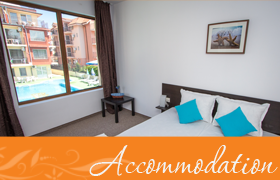Useful
Near the Black Sea town of Sozopol and Ahtopol is one of the most beautiful resorts on the Bulgarian Black Sea coast - Primorsko. Located in southeastern Bulgaria, near the city of Bourgas, the town is the administrative center of the municipality of Primorsko.
Primorsko coast is dotted with the ruins of great cities. The hill called Wolff's stronghold, in ancient times there was located the ancient city Ranuli with a huge wall and an area of about 30 acres. This wall is one of the - largest ever built in Bulgaria.
After a long search of archaeologists, in 2003 they found the ruins of sanctuary - Ranuli. Very often, the sea washed ashore pieces of ancient pottery. That is where scientists discovered preserved sanctuary-observatory, built by arranged in an irregular circle massive stone pieces through which the sun's rays penetrate in certain days of the year. In the sanctuary there is a separate sacrificial altar, altar, throne and the largest known to science up to now dolmen.
Primorsko is situated between the lagoon-Stamopolu Bay and Devil's Bay, which are located at the foot of Strandja peaks, on a peninsula jutting out into the Black Sea.
In Primorsko the summer is characterized by the - lowest rainfall in Bulgaria and maximum temperatures reached no more than 32-33 degrees Celsius. The climate is subtropical and wettable and the average temperature during the summer is 27 degrees Celsius, and the seawater temperature - 26 degrees Celsius. Average minimum and maximum temperatures are positive throughout the year, but autumn is warmer than spring, which dues to the Black Sea. Jutting out deep into the sea, Cape Maslen Nos is the eastern part of the Bulgarian Black Sea coast and the southernmost point of the Bourgas Bay, which in turn predisposes to higher temperatures than the other parts of the southern coast. In a few years there were winters without snow.
During the summer prevailing breezes and in the winter northeastern and north-west winds, and in some cases their speed go beyond 30m/sek. In the region of Primorsko and more precisely in Pearl Residence, have been measured 293 hot summer days in the year. The winter in Primorsko is mild and snowless, but if there still have a snow, it lasts only a few hours, but sometimes up to 1-2 days. Primorsko the winter in is mild and snowless, but if you still have snow, it lasts only a few hours but sometimes up to 1-2 days. The average temperature in December is 8.6 degrees Celsius and the water temperature - 9.5 degrees. Each year Primorsko is visited by millions of foreign and Bulgarian tourists because of its favorable climate, beautiful nature, historical and cultural monuments and of course because of the hospitable population. So this makes the city a favorite place for recreation.
The city has a well developed infrastructure. There is a regular bus service to neighboring cities and resorts, to the capital of Bulgaria and to a number of foreign destinations. Primorsko offers a wide variety of attractions such as surfing, water skiing, water park, jet skis, fishing, walk with boat or yacht, beach volleyball court, tennis courts and many other interesting activities. The city is not lagging behind by the fast food restaurants, bars, discos, restaurants which serve traditional Bulgarian plan kitchen, snack bars and shops.
In 1953 Primorsko was proclaimed a national tourist seaside resort.
Primorsko includes the old town of the city, the new part s.o.Uzundzhata, complex MMC Primorsko and Kiten. In the 80s Primorsko, MMC Primorsko and Kiten are united by the BCP under the name Lazuren Bryag, but with the fall of the BCP The town is divided in 2 cities
During the winter the population of Primorsko numbers 7526 inhabitants, and in the summer on unofficial data exceed the 350,000. The town is connected to other Black Sea resorts - Kiten, Dune, Burgas, Nessebar, Varna through the scenic coastal road. Burgas International Airport is located 60 km from the city, and 3 km is located locally Primorsko airport for small planes.
Near the town of Primorsko is the Ropotamo reserve. It extends on both sides of the eponymous river-Ropotamo. Ropotamo was declared for reserve in 1940 and It is composed of smaller reserves "Arcoutino" - marsh lagoon with Vegetable species, "Snake Island" famous with its cactuses and the snakes, "Sea Wormwood", the name of the herb, "Water Lilies," which includes lily garden in the old riverbed. Ropotamo is about 50 kilometers long, and is formed by the rivers and Tserovska and Rosenska which spring from Strandja. In its upper stream it is freshwater, but approaching the sea it becomes saltwater.
The landscape here is like a paradise - lush greenery on the coasts, which alternates with sand dunes, water is calm, sometimes forming lush meadows and bogs, overgrown with lianas, reeds and irises.
Here are kept more than 11 endangered plants and animal species listed in the Red Book of Bulgaria. It is established the habitat of 226 species. From here goes VIA PONTICA - the road of the migratory birds departing for warmer countries. In this natural area is found about 18% of the flora and fauna of Bulgaria.
All these natural treasures can be seen by boat. In 2003 there was opened a research center equipped with facilities for demonstrations and access to complete information about the area of the reserve. Around Ropotamo river are soaring many interesting rocks as the most popular among them is the Lion's head. It represents many rocks that form the image of a lion's head in profile. There are several legends about this rock, and one of them is that at the top of the rock is situated a well, in which is buried treasure, hidden from Valchan Chieftain. According to some archaeologists, the Golden Lion was the guardian of Tracian fortress Ranuli.
"Arkutino" keeps amazing populations of water lilies. There is located one of the cleanest beaches - boundary between the marsh and the sea and the bed of Ropotamo river is separated from high coastal dunes. The surface of the bog is covered with water lilies and between the reeds and bulrush sneak irises, swans and herons. In 1962, the marsh and the dense forest around it have been declared botanical reserve. The most characteristic feature of the reserve is the presence of lianas.
Beglik Tash is associated with the cult of the Mother Goddess and there were found gems that were offered as gifts to the goddess. Near the altar there is a stone throne of the ruler or priest. On the stones are carved holes which miss sunshine at the solstice that illuminate these points. Sunlight that falls from the main altar, divides the day of 6 equal parts.
It is believed that the construction of the shrine dates back to XIV. in before Christ and did not stop working until the V century It is believed that on the rock bed are gathered in ritual union of the High Priest and High Priestess, and baths which are found around the bed have served to fill with water cooking oil, wine and milk and thus unite all of the earthly powers.
Stone "Apostle tash 'cause particular interest because it is based only on two points, despite their enormous size. In the sanctuary there is a sundial, which will be reconstructed soon. Beside it is situated Labyrinth, where young men framed the direction of their life.
The fortress "Little Kalle" is located 3 km northwest of the "Alepu." From here you have a view, embracing the whole area associated with the life of the Thracians, which have lived during VI-I centuries BC. The area was declared as a cultural monument in 1965. The fortress occupies 4 acres and includes several rock formations, playing the role of fortified towers in antiquity. The necropolis in the fortress is situated near it, and comprises of stone and loose mounds ,and stone circles. In one of the two mounds on found Hellenistic funeral by burning and putting the remains in a clay urn.
On the left side of Ropotamo of the peak of Burhama there is another fortress, which is not visited by a specialist during the last decades
Under the name "Wolff's Kale" we find another fortress again unexplored by archaeologists. According to some authors, there is the medieval fortress Ranuli mentioned in the Hambarli inscription which reflects the victories of Khan Krum in 1812. Right in front of the mouth of the river was located Ropotamo great centuries-old port. First finds of it were found in 1976 at 3.5-4 m. Under the water were found arranged in pairs of poles and beams between thin and coated with clay. The ceramic material dates back to the bronze age - between 2000 and 1750 BC. The port in the early days was called Hersonesos.
Harbor fortress Cape Maslen Nos is very well protected from the north and northeast winds. Found here a different stone and lead remains over the years, antique amphorae and medieval pottery.
Another interesting place is the port "Vetruhi", located southeast of the mouth of the river Ropotamo. The bay is used for refuge to ships in Antiquity and Medieval times.
In the "Kachkata" 3.5 km north of Primorsko, in 1922, the local polulation were digging well when they stumbled on Eolithic findings. Place called Stamopulo which is Greek means to "stop birds."
Snake Island is located northwest of the mouth of the river Ropotamo and is the smallest island in Bulgaria.
Another interesting place to visit is the church "St. Paraskeva" and although it is not a monument of culture, is one of the most interesting places.
Events that are held annually in the town are - celebration of the city on May 24, the traditional international fighting tournament and some other sporting events.


